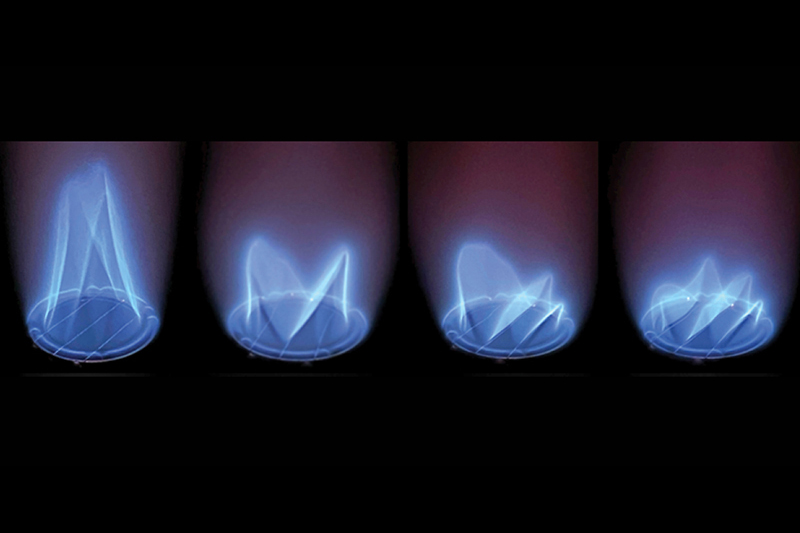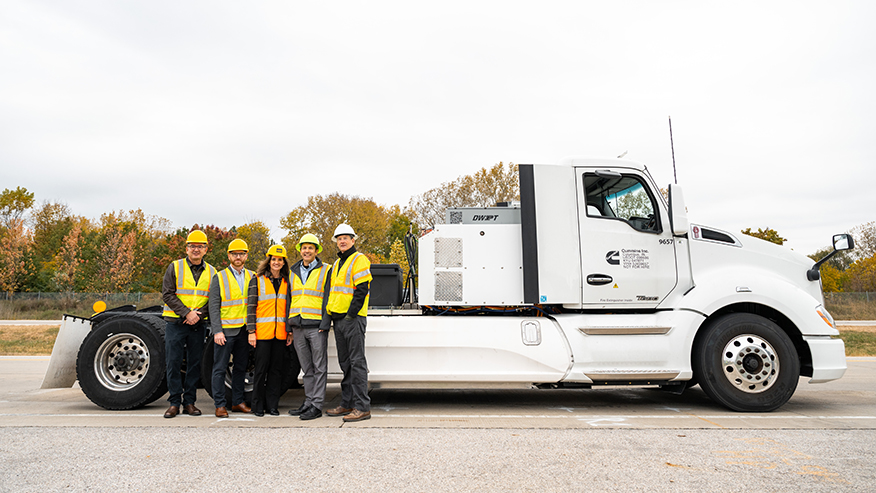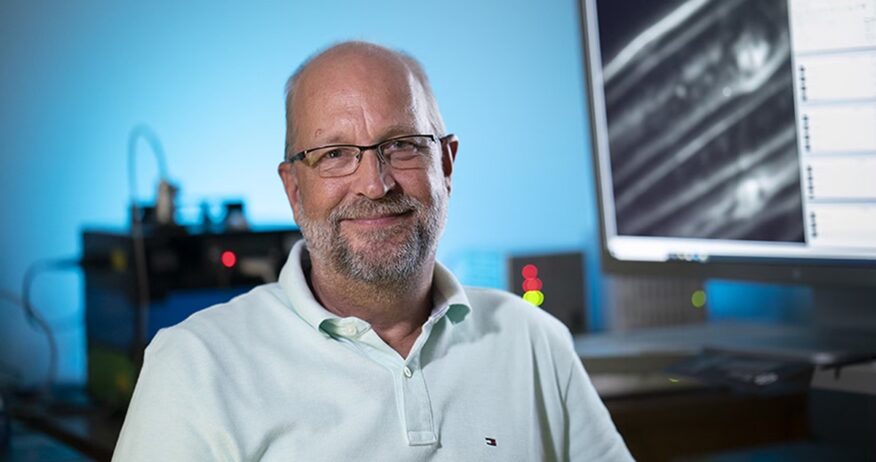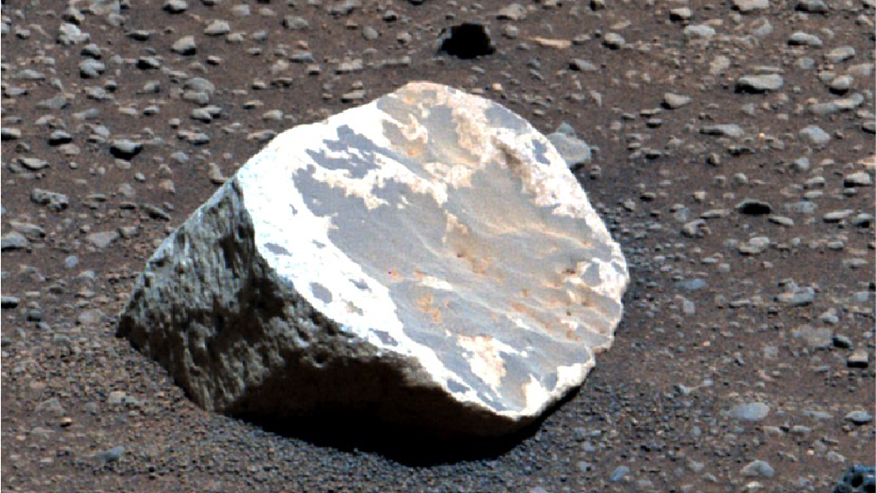Purdue innovations use electric fields and electrode configurations to manipulate a flame’s shape, heat release
Patent-pending innovations’ applications include appliances, gas turbines and industrial burners

Purdue University researchers have created a patent-pending method to dynamically manipulate a flame. The innovation could benefit companies that manufacture gas turbines for aircraft engines and electric power generation, appliances like home furnaces and water heaters, and many types of industrial burners. (Photo provided)
WEST LAFAYETTE, Ind. —
As a flame changes shape by the millisecond, its heat release and stability are affected. Purdue University researchers have created patent-pending methods to dynamically manipulate a flame — from stable to oscillating to agitated — using electric fields and electrode configurations to control its heat release.
The innovations could benefit companies that manufacture gas turbines for aircraft engines and electric power generation, appliances like home furnaces and water heaters, and many types of industrial burners.
Galen King and Dustin Cruise are among the first to conduct research on anchor points to subtly change a flame’s shape and manipulate its heat release. King is a professor emeritus in the School of Mechanical Engineering; Cruise earned his master’s and doctoral degrees under King.
The research about the electric field flame manipulation has been presented at the 2023 American Institute of Aeronautics and Astronautics SciTech Forum and Exposition and the 2023 fall meeting of the Western States Section of the Combustion Institute.
A video showing flames being manipulated using the Purdue method is available on the School of Mechanical Engineering’s YouTube channel.
Why flame stability matters
The global energy supply is predominantly met by the combustion of fossil fuels, which also is the primary source of greenhouse gas emissions. Solutions to reduce emissions can worsen flame stability.
“A lack of flame stability can lead to the flame extinguishing during operation, which has severe consequences in applications like an aircraft engine,” Cruise said. “Issues with flame stability also lead to a greater amount of emissions, premature burner or combustor failure, and excess noise.”
Predicting flame stability issues during the product design phase of industrial or residential products is challenging.
“Discovering issues in preproduction testing or later is prohibitively expensive to solve through redesign, so the only solution is to avoid operating conditions that trigger stability issues,” Cruise said. “But that creates a trade-off between stabilizing the flame and reducing emissions.”
The first Purdue breakthrough
King’s and Cruise’s innovations leverage the charged particles in a flame: positive and negative ions and electrons. The innovations use an applied electric field and electrodes to create multiple anchor points for a flame through the electrohydrodynamic effect. An anchor point is a location where the flame is stabilized. The electrodes are small enough not to interfere with the flame when the electric field is off.
“Creating anchor points significantly alters the flame’s shape and internal volume. This allows for a novel way to affect the flame heat release,” Cruise said. “Affecting the heat release and having some control over it allows suppressing thermoacoustic instabilities — the uncontrolled oscillations of the flame.”
King said, “If you have multiple anchor points on the flame, as created by multiple electrodes, you can have a quasi-linear variation as you change an electric field. This allows you to implement a controller based on that electric field, which alters the flame heat release and, in turn, suppresses the thermoacoustic instability.”
The innovations also allow users to purposefully drive instabilities and oscillations to increase the flame’s heat transfer, which can lead to more efficient, better heat exchangers.
King’s and Cruise’s novel innovations require no moving parts, giving them greater reliability than traditional mechanical actuator designs.
Innovations in electrode design and configurations
King and Cruise built upon their initial breakthrough by creating more complex electrode designs, which allow for more complicated and better control over a flame. They also created electrode pairs that remove all electrodes from within a flame.
“In the original breakthrough, a metal electrode was physically within the flame. This would be unacceptable for many industrial applications: the electrode would erode over time and interfere with the flame and gas flow,” Cruise said. “The new electrode arrangement, called the adjacent electrode configuration, builds all the electrodes into the face of the burner.”
Benefits of the adjacent electrode configuration include:
- Granting greater flexibility in where electrodes can be placed around a burner or combustor.
- Allowing multiple independently controlled electrode pairs, so one part of the flame can be controlled differently than another part.
The configuration features a mechanically simple design with no moving parts and can be constructed from inexpensive, modern electronics. It requires extremely low power to operate.
“For a 3,400-watt thermal power flame, only 0.040 watts of electrical power are required to stabilize it,” Cruise said. “This is 100 times less than other proposed flame actuators.”
The simplicity and low electrical power requirements to create the effect allow for the use of inexpensive electronic components.
“For an application like a residential furnace or water heater, the total cost of the electrodes and high-voltage electronics is in the range of $1 to $5,” Cruise said. “The low cost would allow applying advanced combustion control to even the most cost-sensitive applications.”
King and Cruise disclosed their innovations to the Purdue Innovates Office of Technology Commercialization, which has applied for patents through the U.S. Patent and Trademark Office to protect the intellectual property. Industry partners interested in developing or commercializing the work should contact Jacob Brejcha, licensing associate — physical science, at jjbrejcha@prf.org, about track codes 70043, 70337 and 70476.
About Purdue University
Purdue University is a public research institution demonstrating excellence at scale. Ranked among top 10 public universities and with two colleges in the top four in the United States, Purdue discovers and disseminates knowledge with a quality and at a scale second to none. More than 105,000 students study at Purdue across modalities and locations, including nearly 50,000 in person on the West Lafayette campus. Committed to affordability and accessibility, Purdue’s main campus has frozen tuition 13 years in a row. See how Purdue never stops in the persistent pursuit of the next giant leap — including its first comprehensive urban campus in Indianapolis, the new Mitchell E. Daniels, Jr. School of Business, and Purdue Computes — at https://www.purdue.edu/president/strategic-initiatives.
About Purdue Innovates Office of Technology Commercialization
The Purdue Innovates Office of Technology Commercialization operates one of the most comprehensive technology transfer programs among leading research universities in the U.S. Services provided by this office support the economic development initiatives of Purdue University and benefit the university’s academic activities through commercializing, licensing and protecting Purdue intellectual property. In fiscal year 2023, the office reported 150 deals finalized with 203 technologies signed, 400 disclosures received and 218 issued U.S. patents. The office is managed by the Purdue Research Foundation, which received the 2019 Innovation & Economic Prosperity Universities Award for Place from the Association of Public and Land-grant Universities. In 2020, IPWatchdog Institute ranked Purdue third nationally in startup creation and in the top 20 for patents. The Purdue Research Foundation is a private, nonprofit foundation created to advance the mission of Purdue University. Contact otcip@prf.org for more information.
Writer/Media contact: Steve Martin, sgmartin@prf.org
Sources: Dustin Cruise, dcruise@purdue.edu
Galen King, galenbking@gmail.com



